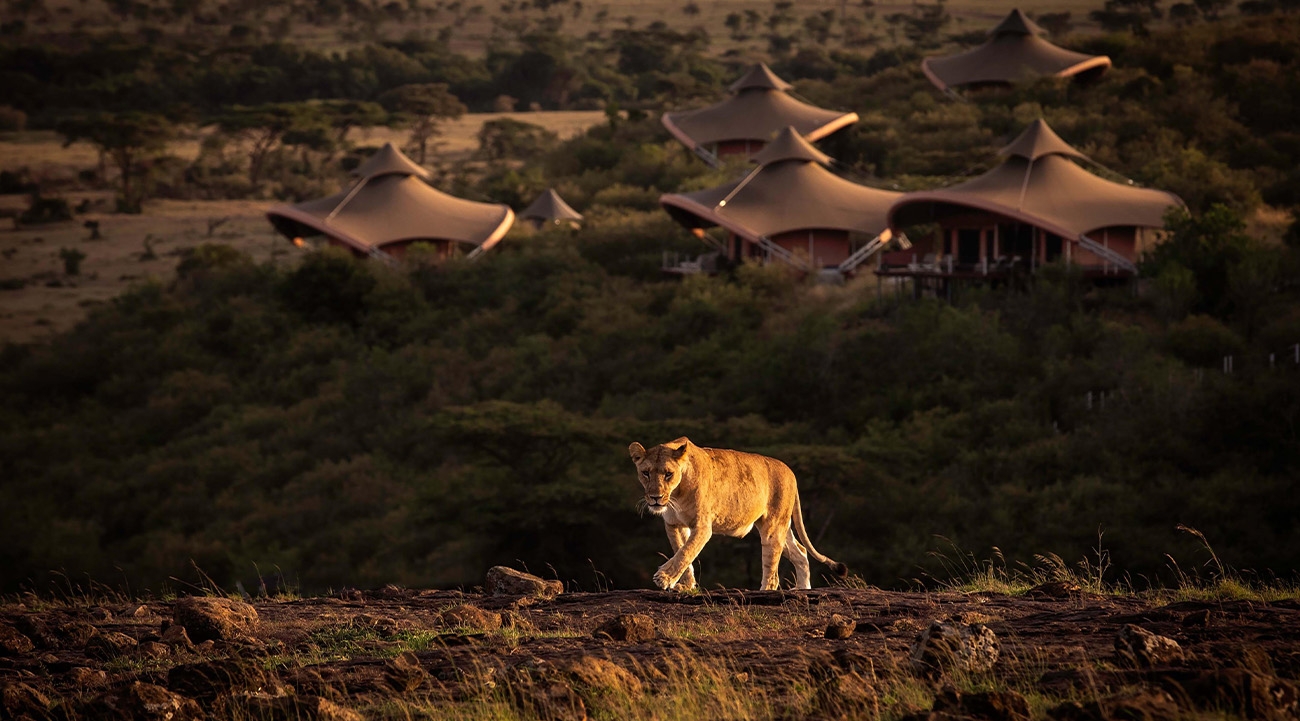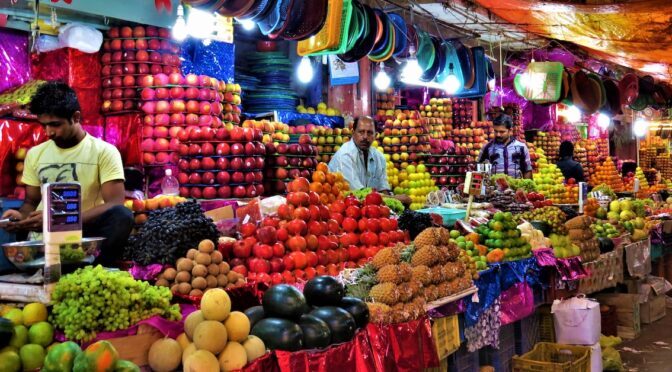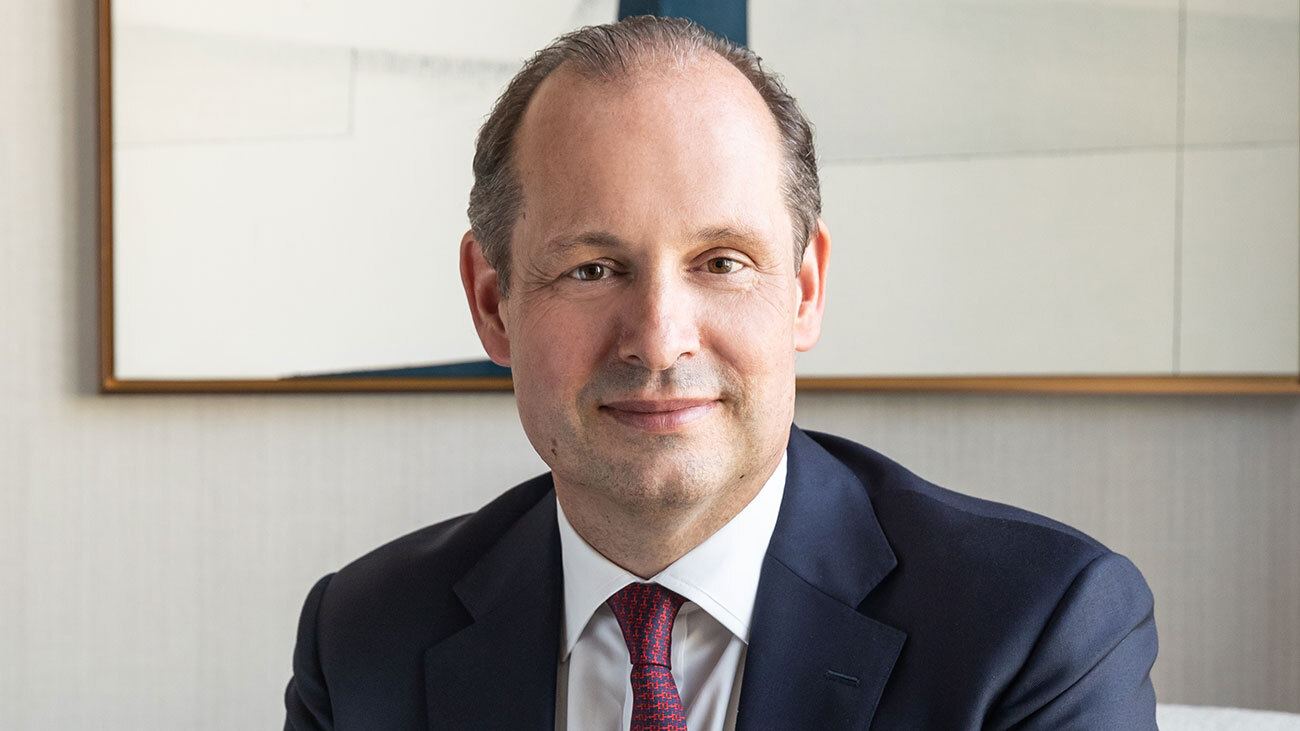Discovering the magic of Virgin Limited Edition’s Mahali Mzuri
The noises started shortly after dinner. Sinister sounds of ravenous grunts, cracking bones and hungry howls of salivating anticipation emanated from the inky darkness. While we polished off our berry pavlovas, word reached us of other diners also tucking into a feast. Lions had made a kill on the helipad. It wasn’t quite what any of us had expected to hear. But then, this was no ordinary safari. Ten years since opening, Mahali Mzuri, the camp owned by Sir Richard Branson in Kenya’s Masai Mara, is celebrating a decade of doing things differently.
Despite the late hour, we raced to the Jeeps and sped to the helipad – a journey of just 20 seconds – where the buffalo buffet was in full swing. Using special infrared night lights, we watched it in all its gory glory, as did the glinting eyes of dozens of hyenas gathered en masse beyond. Located within the Olare Motorogi Conservancy, a private parcel of land that borders the Masai Mara reserve to the south, such encounters are not uncommon at Mahali Mzuri. I first visited the camp within days of its opening and had remained curious in all the years since as to whether its masterplan – to protect wildlife by supporting communities – had come to fruition. Ten years on, it was time to return.
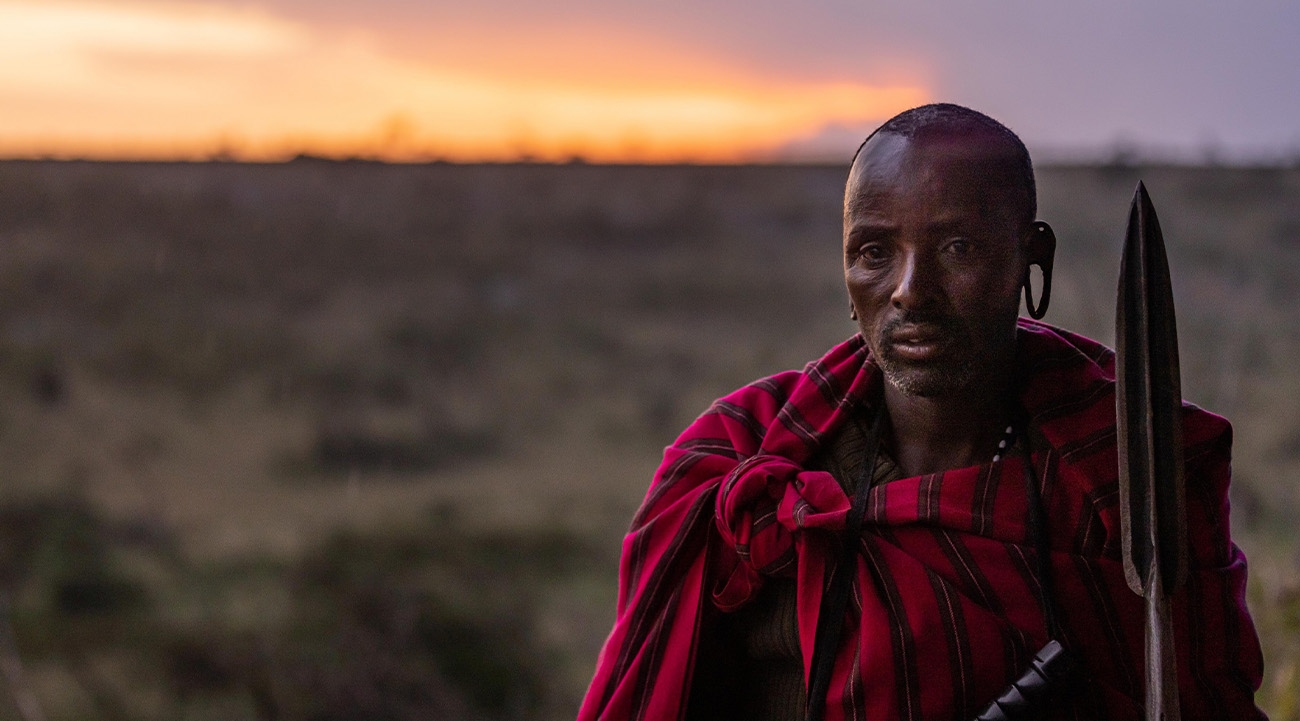


On the horizon
Our journey to the camp had been thrilling too. Excitement rushed through our Cessna aircraft as it dipped low, almost skimming the treetops coming into land after the short flight from Nairobi. Barely an hour had passed since we had been looking down on the urban sprawl of the Kenyan capital before the buildings gave way to a patchwork of dusky greens and rugged browns. Africa’s most fabled wilderness unfurled below us, and if the descent was anything to go by, with sightings of giraffes, elephants and grazing zebras before our wheels had even dusted the dirt-track runway, we were in for a treat.
Parked in the shade of an acacia tree, with a chilled bottle of champagne ready to pop, our guide Kas was on hand to meet us. Recent rains had turned the Mara into a bog land – tricky driving conditions for most but not for Kas, who deftly navigated the waterlogged terrain, all while scanning the plains for creatures big and small. Providing a flash of colour in the distance, a cattle farmer in a brightly coloured shuka (traditional Maasai blanket) could be seen moving his herd.
His presence highlighted the delicate balance between man and beast here in the Mara, which, at times, has been fraught. As visitor numbers to the reserve resulted in changes in animal behaviour in recent years, the conservancies were established to readdress that relationship and Mahali Mzuri – meaning ‘beautiful place’ in Swahili – has played a pivotal role. Unfenced, meaning animals often wander in, the camp is perched on a ridge overlooking a valley on a bend of the Ntiakitiak River, a place popular with spotted cats, striped zebras and other wildlife. Mahali Mzuri consists of 12 futuristic[1]looking tents, centred around a cosy lounge area and restaurant with sweeping views.
At first glance, the tents – built atop soaring steel arches – look a little surreal, like giant manta rays swooping above the valley. But a closer look reveals the design drew inspiration from a Maasai warrior’s bow and arrow. While the exteriors push the boundaries, the interiors are altogether more traditional, with locally made wooden furniture, bamboo light fixtures, Maasai art above the bed and a bathroom boasting a walk-in shower and freestanding bath overlooking the valley.
The canvas sides allow the strange, soothing and, at times, unsettling sounds of the bush to drift in day and night. Elsewhere, there’s a 12-metre infinity pool, plus a heavenly treatment room located at the bottom of 80 steps leading down to the valley floor carpeted with croton bush trees.

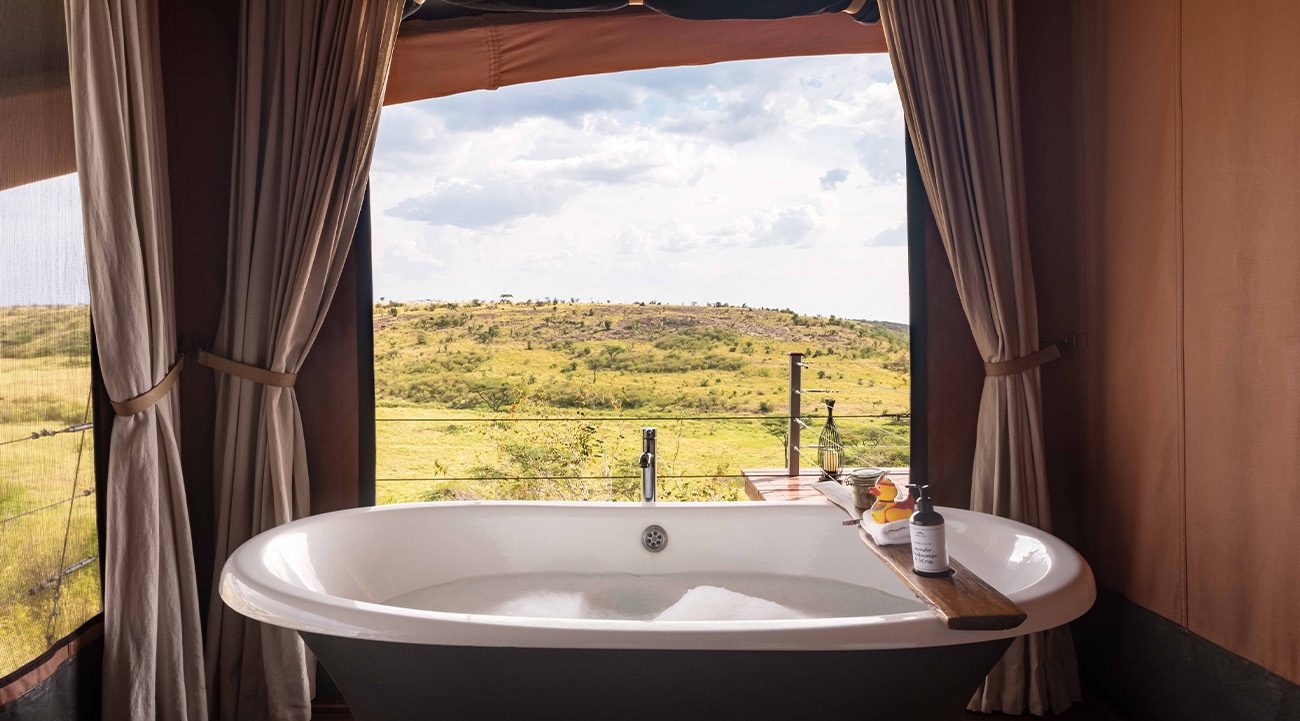
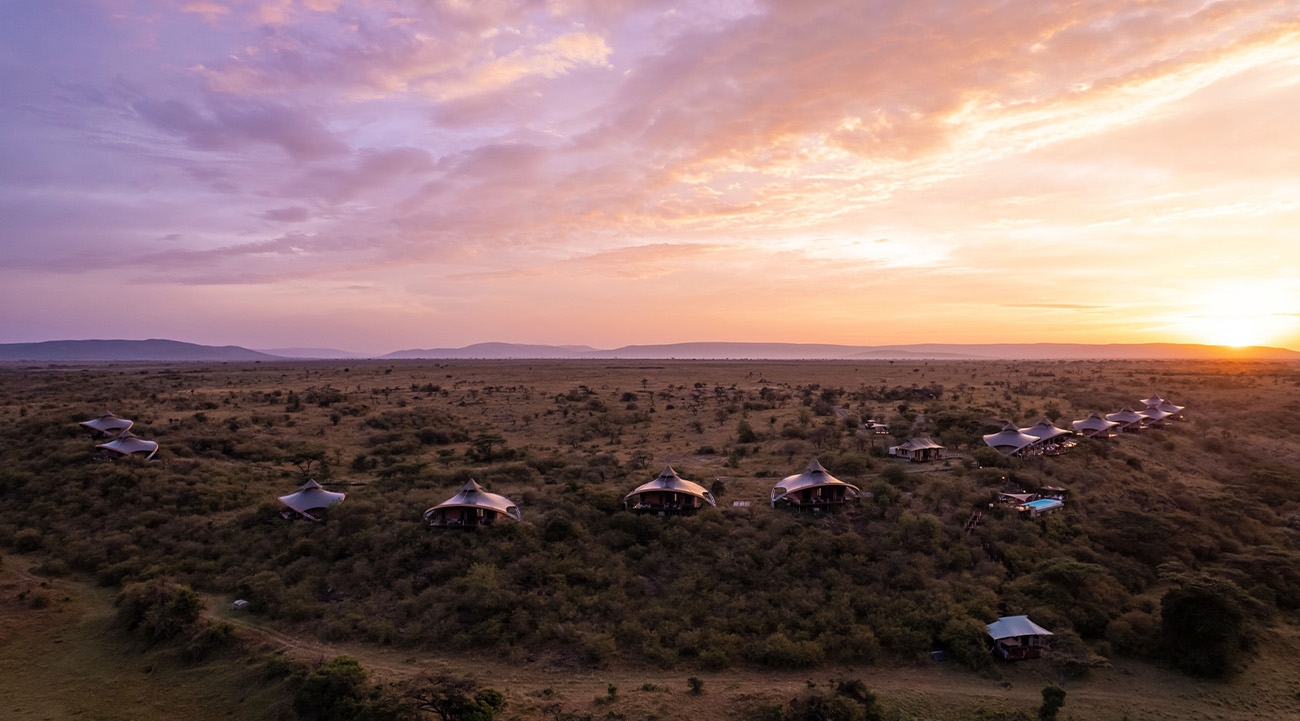
Family affair
It’s very much a family affair at Mahali Mzuri. The camp’s location was chosen by Branson’s son Sam during a camping trip and, among the cosy armchairs, rich tapestries and old leather trunks in the lounge area, are framed photos of Richard taken during his many visits. Guides speak fondly of their time with the big boss, of the pranks he has played on them, and of his enduring love for wildlife (he especially loves lions, apparently), yet this sense of family extends far beyond the Bransons. Many of the team – the vast majority from local villages – were drafted in to help build the camp and have remained ever since. Head waiter Bob Miinta is one such individual.
Having originally been recruited to help with the construction, he later became an askari (a Maasai watchman who escorts guests around the camp during the hours of darkness), before working his way up the ranks. Another is Betty Maite, a softly spoken lady whose gentle demeanour only makes her fierce resolve and admirable determination even more impressive. As one of the first female guides in the Mara, she faced stiff opposition and extreme prejudice while trying to achieve her dream. “It was very hard; everyone said it was a man’s job. Even my dad didn’t think I could do it,” she said. “I wasn’t accepted and I used to cry and get upset, but I kept going.
Now my eldest daughter wants to be a guide too. Things are changing.” Our time at Mahali Mzuri passed in a heady blur of early starts soothed by blankets and hot water bottles; champagne lunches; and fireside sundowners of flames flickering skywards and distant silhouettes of giraffes vanishing into the abyss. And Kas delivered some epic wildlife encounters. We watched in awe as a zebra gave birth, its calf up and on its feet within minutes; with childlike joy as lion cubs splashed in puddles; and with quiet concern for a lone cheetah prowling the plains for a much-needed meal. Best of all, though, was not having to share any of these incredible moments with a convoy of other tourists – a luxury rarely afforded within the heavily congested reserve.

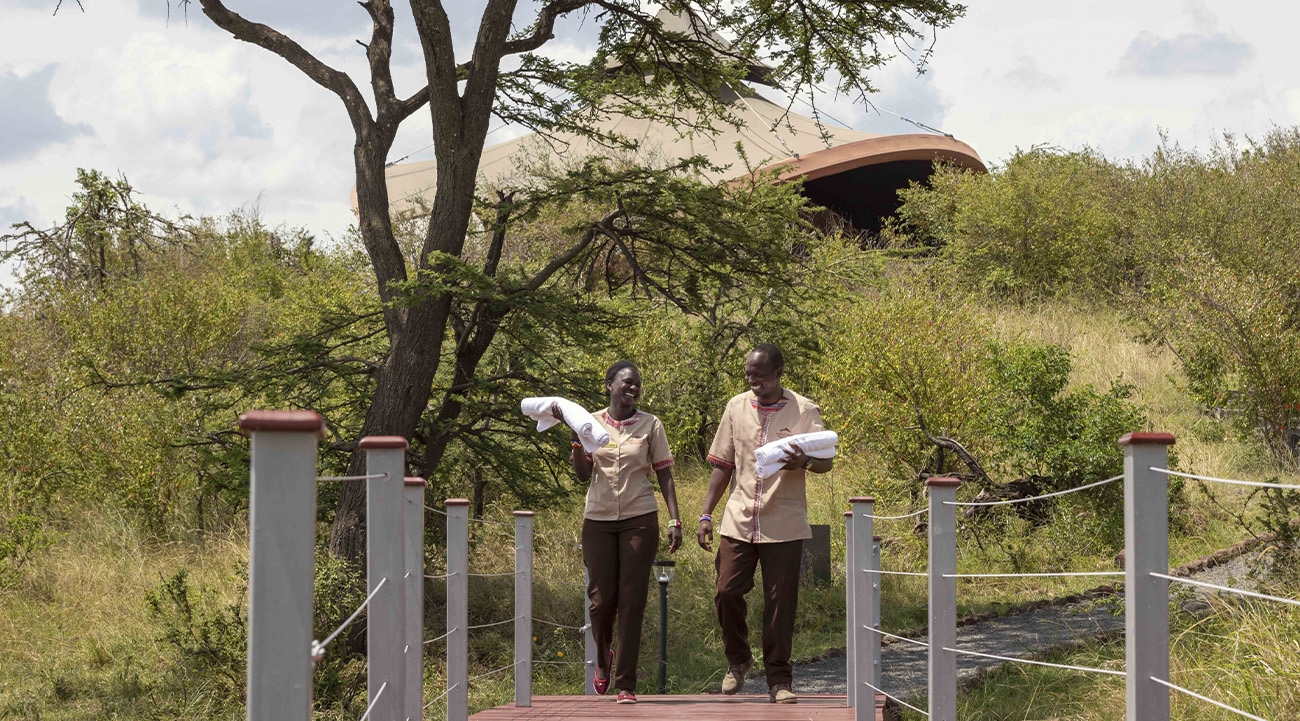
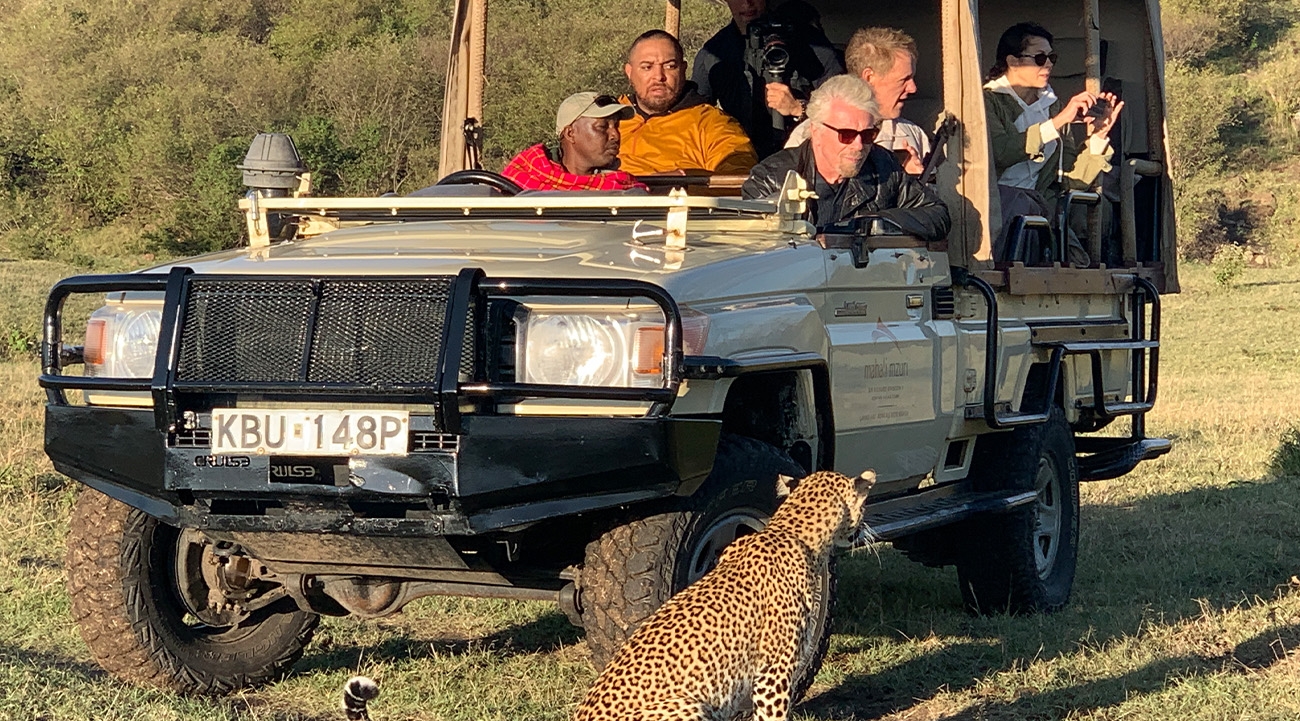
Conservancy benefits
And therein lies the magic of the conservancy model. The Maasai have not always got on with some of their four-legged neighbours. Once upon a time, cattle farmers would target any animal that killed their livestock, erecting fences as added protection. This affected important wildlife corridors and had a devastating impact on the 1.5 million wildebeest and zebras that migrate each year between Kenya and Tanzania.
Radical thinking was required. One person who shared the concerns was Branson. In 2007, the Virgin Group boss met with local conservationists, who expressed their fears for the future of the Mara and all who called it home. “The area serves as a crucial migration route for wildlife travelling to and from the Serengeti,” Branson explained. “We were motivated to find a solution.” Landowners were persuaded to tear down their fences and come together to form a collective area in which a small number of camps, such as Mahali Mzuri, could operate. In exchange, they would receive annual payments, thus directly benefiting from tourism, as well as other incentives such as compensation should their livestock be killed by a predator. It’s not only the locals and wildlife that benefit.
So too do visitors seeking an enriched and lower-impact experience. Fewer camps means fewer people and that, in turn, means fewer vehicles around each animal sighting – something that is strictly controlled and enforced. And with the reserve having recently doubled its fees to about $200 per day, the 13 conservancies – which have now collectively added 50% more land to the Mara’s ecosystem – offer better value for money than ever before. Success like this may have been at least a decade in the making but the best things, as ever, are worth waiting for.


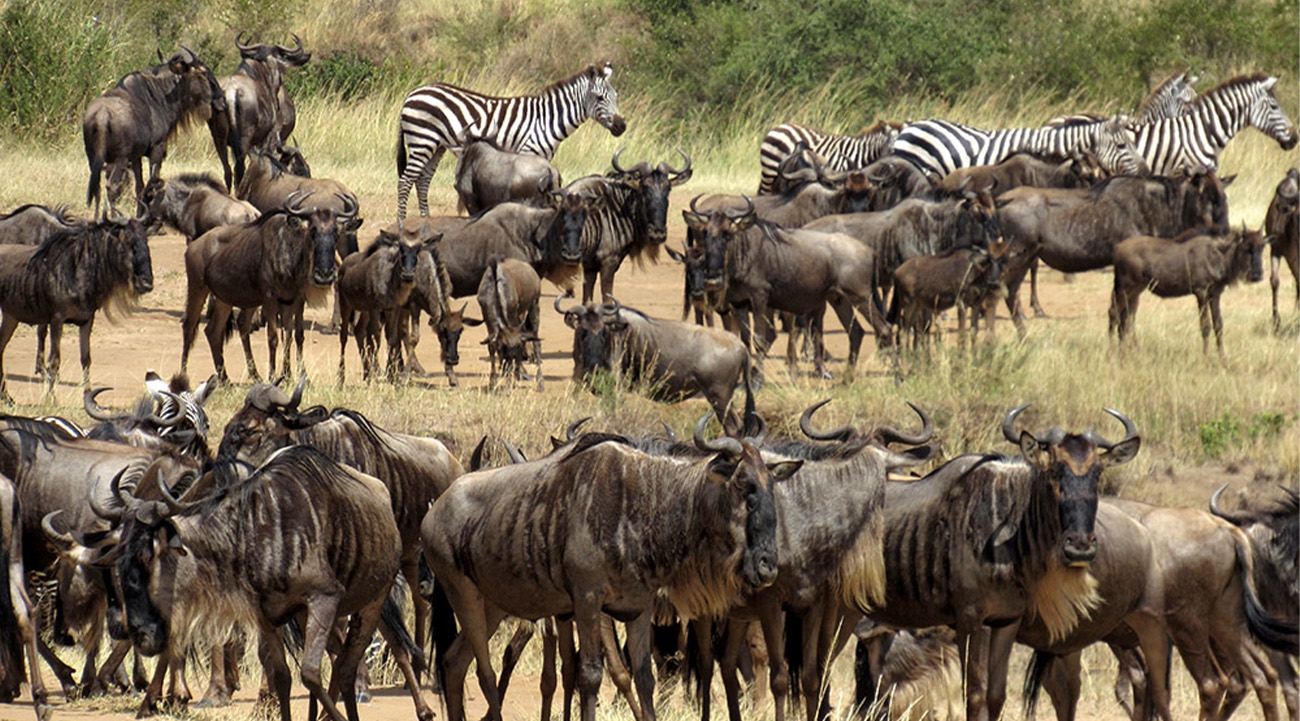
Green & good
The wildlife is merely one important aspect of a trip to the Masai Mara. People also play a huge part and The Maa Trust, a non-profit organisation that supports local causes, offers a unique insight into challenges faced by communities. Supported financially by Mahali Mzuri, the trust helps girls stay in education, aims to empower women through beadwork and provides family planning and healthcare including the Mara’s first hospital.
Meanwhile, green-fingered Mahali guests can get their hands dirty by contributing to an ambitious initiative that will see 15 billion trees planted in Kenya by 2034. We opted for olive trees and planted them in a neat row beside a classroom at a school that offers lessons and lodgings to some 300 children from villages near and far. Those who prefer decorating to gardening can opt to paint a classroom instead, proving that giving back can be both a colourful and rewarding experience.
themaatrust.org
Book it: Elegant Resorts offers seven nights at Mahali Mzuri from £6,648, including meals, drinks, flights, transfers and lounge access.
elegantresorts.co.uk
The streets are alive with thousands of smiling faces. People chant, jeer and cheer in excitement as beautifully coloured dragon boats zip along the Mekong.
Elsewhere along the waterside, families enjoy picnics outside the Royal Palace, children scream with delight as they go head to head with tourists in a friendly game of football, and locals delve into Cambodian delicacies such as fried crickets and tarantulas.
I try to soak in the sights and scents, overwhelmed by everything around me. This isn’t chaos as I know it in London, and there’s certainly no shoving to get on a Tube.
In fact, despite hundreds of thousands of people descending on Phnom Penh for the Water and Moon Festival, there is complete harmony around me.
I arrive in the Cambodian capital just in time for the festival. The event is usually an annual affair, but a stampede five years ago caused the government to pull the plug. The hiatus has clearly caused pent-up demand. Cambodians have travelled across the country for this special occasion, and they couldn’t be happier to see dozens of boats racing up and down the river. The beaming smiles of the locals are infectious, and I’ve already fallen for this mystical city and its people.
After hours of roaming around on foot and by cyclo, I end the day with my legs hung over the edge of the riverbank, with the mighty Mekong before me and close enough to the action to be splashed by the lapping water, caused by the motion of 40 oars hitting the water in unison. I can’t help but smile as winning teams chant and sing in the direction of the King, who is proudly sat in an enclosure just a stone’s throw from where I’ve plonked myself. He, however, opted for a throne-like chair rather than the concrete floor.
RECENT TRAGEDY
My experiences a day earlier at the capital’s genocide museum and Killing Fields memorial resonate with me more than ever as I sit among the beaming locals.
Cambodians have a remarkable outlook on life – most likely due to their Buddhist culture – despite a tortured and still widely remembered history at the hands of dictator Pol Pot’s brutal Khmer Rouge regime in the 1970s.
Learning about Cambodia’s recent past is just as important as learning about its ancient history. Just four decades ago, between two and three million Cambodians died from starvation, execution and disease – around a quarter of the population at the time.
First we visit the Tuol Sleng Genocide Museum – a high school- turned-prison camp where row upon row of photos of prisoners are exhibited alongside the tools and instruments used to torture them.
Our guide stops to show us the blood-stained floors beneath us and to explain his story – that his parents, siblings and grandparents were all killed by the Khmer Rouge. It’s here that my emotions get the better of me and I can’t stop the tears rolling down my cheeks.
From there we visit the Killing Fields, where the vast majority of prisoners lost their lives. The fields are constantly excavated, with teeth and bones regularly discovered. In a moment of solitude and reflection, I’m left speechless when my guide thanks me for wanting to learn about the horrors experienced less than half a century ago.
UPSCALE OFFERING
I was lucky enough to call the city’s most famous hotel, Raffles Hotel Le Royal, home during my stay. I call it home because that’s exactly how it felt every time I returned to the property, which leads the luxury offering in the capital.
Sister property Grand Hotel D’Angkor is also among the more opulent and luxurious properties in Siem Reap, and this was my home from home during my time in this ancient part of Cambodia. Siem Reap is best known as gateway to the ancient temples located close by, and as a backpackers’ haven. But its luxury offering is escalating, with a wide range of high-end hotels, including the 39-suite boutique property Shinta Mani, a Park Hyatt and Belmond’s La Résidence d’Angkor.
While the temples understandably steal the spotlight, there is plenty more on offer here. One such experience is Phare, a contemporary circus act that sees somersaulting young Cambodians tell folklore tales.
Siem Reap itself is a hive of activity, although some might feel the central market areas are touristy.
The temples of Angkor are magical, and visitors to the area should make the most of a multi-day pass to see the diversity in design. The Angkor complex, however, is vast, and those with limited time should head straight to the Bayon temple, Ta Prohm and Angkor Thom. Sunrise is best spent in front of Angkor Wat, where misty red and pink pigments slowly rise above the majestic temple. It’s a breathtaking experience, and one not to be missed.
This wasn’t my first visit to the ancient temples of the historic city of Angkor, but I was equally, if not more, awestruck the second-time round.
This time, a day scaling and exploring multiple temples ended in sheer luxury – sailing along a moat that once served Angkor Thom on a beautiful dragon boat, similar to those I’d seen on the Mekong days earlier. I watched, with a gin and tonic in hand, as the sun dipped out of sight, to be replaced by a bright white supermoon hanging low over the waters – the perfect way to reflect on my majestic Cambodian experience.
